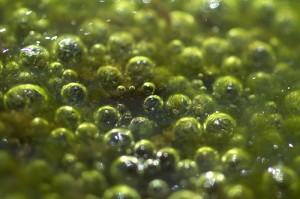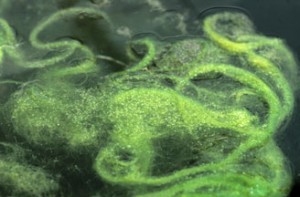
Let’s go deeper…
Green water*, is probably the most common pond algae issue that pond and water garden owners face at sometime and thankfully one that can be eliminated! Green water is not necessarily bad for fish or the overall health of the pond, but it sure is not what we’re hoping for when our ponds were installed. The shades of green water can vary from a deep green/black to a bright lime green color. Green water is created by plan ktonic algae cells suspended in the water. The green water condition in backyard koi ponds and water gardens is typically a symptom of an under filtered pond. The nutrient levels (a.k.a algae food) in your pond are rising faster than the filter system can break them down. This excess of nutrients gets consumed by the planktonic algae, they become fat and happy pond algae cells and turn green. And in turn your pond water turns green. These little tiny floating plants are just doing what plants do, and turning green by producing chlorophyll. Temporary greening may occur from heavy rains that are rich in nutrients (nitrate) or water changes which sometimes contain phosphate. This temporary greening will usually come back into balance in a short time. Chronic green water lasting 3 weeks or more, needs to be addressed.
ktonic algae cells suspended in the water. The green water condition in backyard koi ponds and water gardens is typically a symptom of an under filtered pond. The nutrient levels (a.k.a algae food) in your pond are rising faster than the filter system can break them down. This excess of nutrients gets consumed by the planktonic algae, they become fat and happy pond algae cells and turn green. And in turn your pond water turns green. These little tiny floating plants are just doing what plants do, and turning green by producing chlorophyll. Temporary greening may occur from heavy rains that are rich in nutrients (nitrate) or water changes which sometimes contain phosphate. This temporary greening will usually come back into balance in a short time. Chronic green water lasting 3 weeks or more, needs to be addressed.
String / Hair / blanket algae blooms can occur for much longer periods of time than the issues of green water or floating algae. Its appearance is long hair like strands growing on the surface of liner, equipment, rockwork, and/or plants. It can grow in dense matting or have sparse growth; but this type of algae is always attached to a surface. It is the most common algae that occurs in stream and waterfall areas of your pond or water garden. String algae blooms are a common (normal) occurrence in early winter and early spring/late winter, but can persist year round in problem cases. String algae in small blooms do not cause any immediate health issues to the livestock in your pond or water garden, but long lasting blooms are highly undesirable and can cause pond issues as serious as livestock loss if not addressed. The early winter bloom likely occurs around the time that the aquatic plants in your pond have stopped “eating” and are getting ready for dormancy, microbial processes within the pond have slowed, Mother Nature is raining down all the leaf and plant debris she can into your pond, and materials are not breaking down efficiently which raises nutrient levels. The pond suddenly has a nice glut of food (nutrients) on the market and algae are willing to exploit that. With an abundant food supply and no other plant competition, the string algae bloom is underway! Typically in a few weeks it lessens or clears up. In early spring the aquatic plants have not woken from their winter slumber, most filters have not been serviced all winter, old man winter has dumped several months worth of debris into your pond, temperatures start rising and again algae finds a huge food supply all to itself this time of year. BAM! String algae bloom underway. Many pond pros are proponents of the “let it bloom and fade” method. For others the pond algae  bloom can be manually removed and treatment applied.
bloom can be manually removed and treatment applied.
Floating algae is the least common algae that occurs in most koi ponds and water gardens; especially ponds that use skimmers as a part of the filter system. It appears as a “puffy” type of pond algae with a brown/green color and is of course, floating. The floating algae that we see in our koi ponds and water gardens usually occur in “dead zones” of circulation, very shallow areas, and ponds that are in real need of cleanout. Like string algae, floating algae can occur in green water conditions or when pond water is very clear and otherwise healthy looking. Floating pond algae in natural ponds, and farm ponds is a much more common occurrence and is often accompanied by string algae growth and green water conditions. Floating algae is very unsightly, but also the easiest to get rid of.
Let’s fight back…in Part 3 of THE ALGAE TRILOGY
(*green water caused by blue/green algae, cyanobacteria, is harmful and toxic to humans and wildlife. The information discussed here does not apply to Cyanobacteria blue green algae blooms)
All copyrights to this material is solely owned by Mike Gannon.

Sir,
i have experienced a situation in which green algae turns brownish red during the day light (sunlight may be) and again turns green after evening in a pond. I am not getting why this is happening. please explain this phenomenon?
Hello. There are too many variables, too many factors to consider, and lots of missing information for me to really be able to answer your question, I’m sorry. Have you identified what type of algae this is? Are you certain that it is an algae growth? -Mike
Feel free to email me directly if you would like to include photos, etc.
i am confused & hope you can help. had this pond for 16 years. size approx. 14 feet long x 10 feet in widest spot, 24″ deep .with two 24″ koi and one 12″. on 4/21/18 a pond builder cleaned pond completely & removed all pennywrort plants that had overtaken pond during winter
including what grew between rocks on waterfall. when fresh water &
koi returned to pond water was still brownish looking which he felt would clear in a day or so. (the filter, a tank type with matala blue filter)
was wiped out only. 2days later the brownish. water turned to kelly green & has remained so to date. i started algae fix for 4 or 5 doses for
several weeks but to no avail. I also added m.lift pbl & am continuing th
that about 8 oz – 1 x weekly. am on third dose next week. still green h2o.
in desperation i called pond technician at the lab that makes many of products i use and was told to stop algae fix, use pbl as i described, and
that i needed to get pennywort growing in pond AND string algae. i asked why string algae? the reply was …”you cannot have both at the same time”. i assume she means that re-growth of plants plus growth of string algae would help to eradicate the planktotic algae. i have never heard or read that string algae was beneficial in this particular way. would very much appreciate your thoughts on this. and how long we & the koi have to live with this situation. many thanks.
Hi Betty. Thanks for reaching out. I would agree that string algae can have several benefits for a pond, including helping to clear water; but most pond keepers do not want to see the algae. I personally let the string algae bloom in my pond every year and then it goes away on its own. I’m not sure you necessarily need the pennywort again since you have MANY aquatic plants you could choose from that will provide the same benefit. Green water is usually just a [pond that is out of balance. If you pond has been balanced in the past, it will likely balance out with clear water again, but it can take several weeks at times. I’d keep with the addition of beneficial bacteria and give it a little time. Green water does not hurt the fish. If you want “overnight” clearing of the water just get an ultraviolet light. Good luck! -Mike
I don’t see the algae mentioned above that I have in my pond. It’s a dark green slim that builds up in my skimmer and filer. It covers the bottom and sides of my 8,000 gal. koi pond. I have 8 large koi that do seem to eat it. If I don’t clean it out every day, the pond gets cloudy. I also have a waterfall that is covered in this black slime. Every so often, I get a putty knife and scrape it off the rocks. Can you tell me what kind of algae I have and how to treat it?’ Thanks
Bari
Hello Bari. Although I don’t have the exact name of that type of algae I am familiar with it and encounter it in many of the ponds that I deal with. I would not put alot of effort into getting rid of it since it is not a bad thing at all apart from not looking nice. If you want to get rid of it so the pond looks nice then try some of the powdered algae treatments like “EcoBlast” or “String Algae Buster” to keep the growth better controlled. Good luck. -Mike